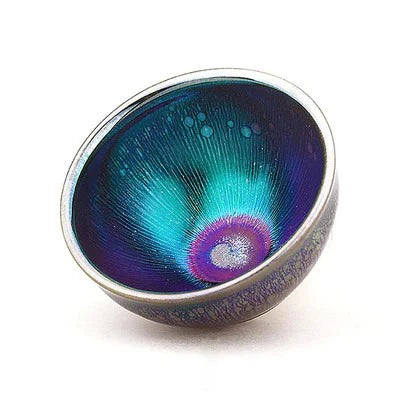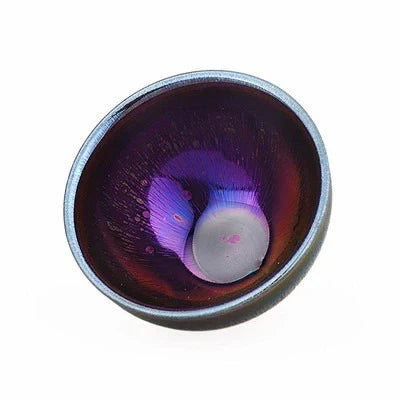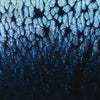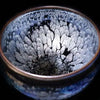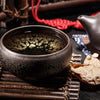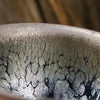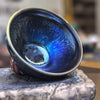WOOD-FIRED & ELECTRIC-FIRED JIANZHAN.
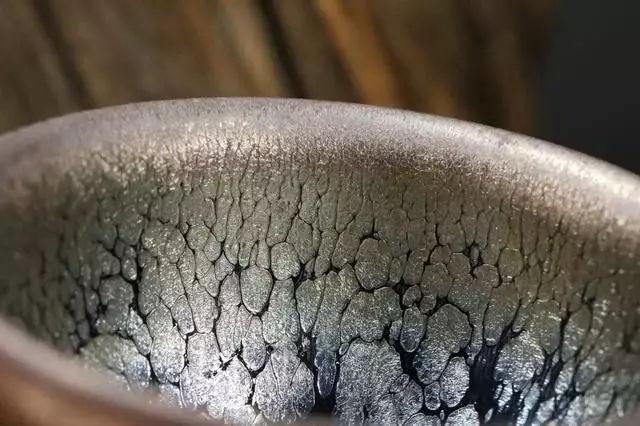
Jianzhan teacups, though fired in a single color, emerge from the kiln displaying a stunning variety of shades and hues, a phenomenon that is both the allure and the challenge of wood-fired Jianzhan. Within the same kiln, Jianzhan pieces can display dramatically different glaze colors, even if they are fired in identical conditions or positioned side-by-side in the same kiln chamber.
When comparing wood-fired and electric-fired Jianzhan with identical patterns, the wood-fired piece is generally more desirable. Both types use the same raw materials, yet the kiln environment and heating method differ significantly. The intense heat in wood kilns often yields a smoother, richer glaze that enhances the visual appeal of wood-fired Jianzhan.
The process behind Jianzhan’s patterns is intricate and highly sensitive to precise timing and temperature control; if these conditions shift outside a very narrow range, the patterns will not form as intended. While both wood-fired and electric-fired Jianzhan face this challenge, electric kilns offer a more consistent and controllable environment, which has enabled artisans to create effects that are challenging for wood-fired methods. In fact, the technical advancements in electric firing have addressed many of the limitations of wood-firing, aiding in the industry’s growth. This progression has indirectly supported the resurgence of wood-firing techniques, although substantial breakthroughs in wood-fired craftsmanship are still limited.
Historically, Jianzhan teacups were produced exclusively using wood-firing. However, as electric kilns became available, the technique evolved. So, what are the key differences between traditional wood-firing and more modern methods such as electric, gas, or coal kilns?

Differences Between Wood-Fired and Modern Firing Techniques
The main contrasts between wood-firing and contemporary firing methods can be summarized in a few points.
-
Temperature Fluctuations and Glaze Texture
Wood-firing involves a constant addition of wood to maintain heat, which causes temperature variations throughout the process. This fluctuation results in a more varied bubble structure within the glaze, creating a layered, textured effect. Modern electric and gas kilns, in contrast, offer more stable heating, producing consistent, fine bubbles and a smoother finish. -
Color Variations
With the temperature inconsistencies in wood-fired kilns, colors on a Jianzhan teacup can vary widely, showing depth and tonal gradients. Gas and electric kilns, however, maintain steady temperatures, resulting in more uniform color tones across each piece. -
Ash Residue and Natural Effects
Wood-fired kilns allow ash and flames to flow freely, often settling on the Jianzhan surface. This natural ash infusion, when fused with the glaze at high temperatures, adds warmth, texture, and a unique layered appearance to the final product.
While these distinctions help to identify differences between wood-fired and modern techniques, it’s worth noting that some modern kilns can now replicate many of wood-firing’s effects. Therefore, these guidelines serve more as general indicators rather than strict rules.

Why Are Wood-Fired Jianzhan Teacups So Costly?
The higher price of wood-fired Jianzhan is largely due to the complexity and restrictions associated with the wood-firing process. Wood-firing is typically prohibited without special permits to protect natural forest resources, and firing in a wood kiln demands significant financial investment and technical skill. The process is far more complex than simply building a kiln and using firewood.
Wood-firing is a centuries-old tradition that originally required artisans to shield porcelain pieces to prevent ash from contaminating the glaze. Modern techniques, however, embrace the interaction between wood ash and the clay, creating a distinct aesthetic that merges nature with craftsmanship.
The results of each firing are unpredictable, and every wood-fired Jianzhan is genuinely unique. This ancient firing method, relying on a direct connection between the kiln master and the flames, produces extraordinary ceramic art distinguished by “yin-yang” contrasts between heated and non-heated surfaces, as well as flame marks that contribute to a rustic, profound beauty. The unpredictability and natural artistry of wood-firing continue to captivate ceramic artists, inspiring them to master and preserve this time-honored technique.


